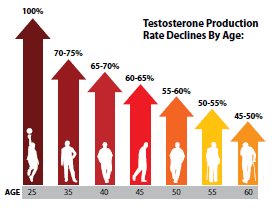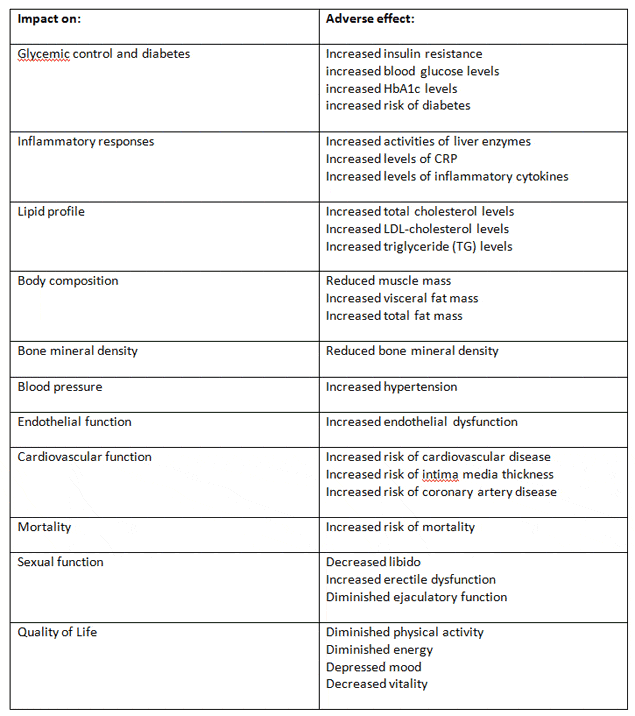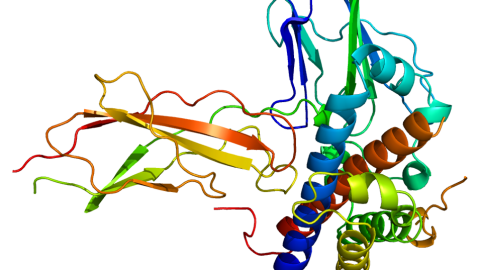Testosterone deficiency and treatment is a very misunderstood and controversial topic among scientists, regulatory agencies (such as the FDA and EMA) and doctors, as well as the popular media.
On October 1, 2015, an international expert consensus conference about testosterone deficiency and its treatment was held in Prague, sponsored by King’s College London and the International Society for the Study of the Aging Male (ISSAM). The impetus for this meeting was to address the widespread misinformation and confusion about testosterone deficiency and testosterone therapy.[1]
The ultimate goal of this consensus conference was to document what is true or untrue about testosterone deficiency and testosterone therapy, to the best degree possible based on existing scientific and clinical evidence.
There were 18 experts from 11 countries on 4 continents. Specialties included urology, endocrinology, internal medicine, diabetology, and basic science research. Experts were invited on the basis of extensive clinical experience with testosterone deficiency and its treatment and/or research experience.
The final consensus on several key issues related to testosterone therapy was published in the form of 9 resolutions – i.e. facts – coupled with expert comments [2], which I summarize here….
Table 1: Resolutions of the International Expert Consensus Conference on Testosterone Deficiency and Its Treatment.[2]
|
Resolutions (Facts) |
Expert comments |
|
1. TD is a well-established, significant medical condition that negatively affects male sexuality, reproduction, general health, and quality of life.
|
TD (low levels of testosterone): – May predict increased risk of developing diabetes, metabolic syndrome. – Contributes to decreased bone mineral density. – Is associated with increased all-cause and cardiovascular mortality. – Negatively impacts general health and quality of life. |
|
2. The symptoms and signs of TD occur as a result of low levels of T and may benefit from treatment regardless of whether there is an identified underlying cause.
|
– Symptoms and signs of TD occur in healthy volunteers or patients who undergo androgen deprivation; these symptoms and signs resolve with T normalization. – Historically recognized causes of TD are rare (eg, anorchia, craniopharyngioma, pituitary tumor), recently termed classical hypogonadism. These conditions account for only a tiny fraction of men with TD. – TD occurs frequently with conditions other than “classical” causes. – No evidence exists to support restriction of T therapy only to men with known underlying cause. |
|
3. TD is a global public health concern.
|
– Prevalence rates in men range from 2% to 38% in studies from Asia, Europe, North America, and South America. – Variation in prevalence rates can be explained by differences in the definition of TD and T thresholds. – A US study estimates an additional $190-$525 billion in health care expenditures over 20 years due to TD. |
|
4. T therapy for men with TD is effective, rational, and evidence based.
|
High-level evidence shows T therapy effectively: – Increases sexual desire (libido) and erectile and orgasmic function. – Increases lean body mass. – Decreases fat mass. – Improves bone mineral density. Strongly suggestive evidence for improvement in mood, energy. |
|
5. There is no T level threshold that reliably distinguishes those who will respond to treatment from those who will not.
|
No study has revealed a single testosterone threshold that reliably separates those who experience signs and symptoms of TD from those who do not, nor who will likely respond to treatment. Interpretation of total T levels is confounded by: – Inter-individual variation. – Variation in serum SHBG (binds tightly to T, removing it from the bioavailable pool). – Genetic variation in androgen receptor sensitivity. Free T can be a useful indicator of androgen status. |
|
6. There is no scientific basis for any age-specific recommendations against the use of T therapy in men.
|
– The term age-related hypogonadism is of questionable validity since the decline in mean serum T level with age is minor and primarily attributable to comorbidities, especially obesity. – Older men respond well to T therapy, as do younger men. – Increased risk of erythrocytosis (increased red blood cell mass) in older men requires monitoring but does not merit withholding T therapy if indicated. – It is illogical to single out TD as the one medical condition among many (e.g., diabetes, hypertension, heart disease, cancer, arthritis) that does not merit treatment because it becomes more prevalent with age. |
|
7. The evidence does not support increased risks of CV events with T therapy.
|
– Two observational studies received intense media attention after reporting increased CV risks. Both had major flaws/limitations. One misreported results, the other had no control group. – Low serum T is associated with increased atherosclerosis, coronary artery disease, obesity, diabetes, and mortality. – Several RCTs in men with known heart disease (angina, heart failure) showed greater benefits with T vs placebo (greater time to ischemia, greater exercise capacity). – The largest meta-analysis showed no increased risk with T therapy; reduced risk was noted in men with metabolic conditions. – No increased risk of blood clots (VTE) with T therapy. |
|
8. The evidence does not support increased risk of PCa with T therapy.
|
– Blood androgen levels are not associated with increased risk of PCa nor aggressive PCa. – T therapy has no greater risk of PCa than placebo. – Aggressive/high-grade PCa is associated with low serum T levels. – Early data suggest no increased risk of recurrence/progression with T therapy in men previously treated for PCa. |
|
9. Evidence supports a major research initiative to explore possible benefits of T therapy for cardiometabolic disease, including diabetes.
|
– A large body of evidence suggests lower serum T concentrations are associated with increased CV risk; higher levels are protective. – T therapy reliably increases lean mass, decreases fat mass, and may improve glycemic control. – Mortality rates are reduced by half in men with TD who received T therapy compared with untreated men in observational studies. – Among men who received T therapy, those with normalized T levels had a reduced rate of CV events/mortality vs men with persistently low T. |
|
Abbreviations: CV; cardiovascular; PCa; prostate cancer; RCT; randomized controlled trial; SHBG; sex hormone binding globulin; T; testosterone; TD; testosterone deficiency; VTE; venothrombotic events. |
|
In Nov 2014 and Jan 2015, intense myopic attention was given to 2 flawed studies purporting increased CV risk, leading to criticism in both medical and lay press against the use of testosterone therapy, and issuance of warnings by regulatory agencies.
Public criticisms of testosterone therapy has trivialized the symptoms of testosterone deficiency, questioned the very existence of testosterone deficiency as a medical condition, asserted that the benefits of testosterone therapy are unproven, and exaggerated the cardiovascular and prostate cancer risks associated with treatment. These and other criticisms, together with responses by the expert panel, are summarized in table 2.
Table 2: Common Concerns Regarding Testosterone Deficiency and Testosterone Therapy and Consensus Conference Expert Responses.[2]
| Concerns about TD and T therapy that have appeared in the scientific and lay media | Expert responses |
| – The condition of low-T does not exist. | False. Low-T is an informal term used to describe TD, much as “heart attack” is used in place of myocardial infarction. TD is a well-established medical condition described in all general medical textbooks. |
| – The symptoms of TD do not merit treatment, particularly decreased libido and fatigue. | The symptoms of TD are of considerable importance to many affected men. However, decisions regarding treatment must be individualized. |
| – T therapy is risky. | All medical treatments entail some degree of risk. Known risks of T therapy include acne,gynecomastia, peripheral edema, infertility, decreased testicular volume, anderythrocytosis.These are reversible with discontinuation of treatment. The evidence fails to support assertions that T therapy is associated with increased CV risk or PCa. |
| – T therapy increases risks of VTE, such as deep venous thrombosis or pulmonary emboli. | Available evidence reveals no increased risk of VTE with T therapy.[3] |
| – T therapy increases the risk of myocardial infarction, stroke, and death. | Two flawed studies reporting increased CV risk with T therapy received enormous media attention. One misreported primary results [4] and the other [5] had no control/comparison group.In contrast, several dozen studies provide high-level evidence that reduced T levels are associated with atherosclerosis and increased CV events, whereas T therapy appears to reduce CV risk or improve known CV risk factors.[6] |
| – T therapy causes PCa to develop or become aggressive. | Not supported by evidence. Longitudinal data reveal no relationship between higher serum T level and PCa risk.[7]Meta-analyses found no greater risk of PCa in men who received T therapy compared with placebo.[8]High-grade disease and poor prognostic PCa features are associated with low serum T levels.[9] |
| – T therapy is experimental/investigational. | False. T therapy has been a standard form of medical treatment for men with TD for more than 70 years, with numerous studies documenting benefits and a reasonable safety profile.[6, 10] |
| – The decline in T is due to normal aging and does not merit treatment. | Age alone has little impact on serum T concentrations. Most of the age-associated decline in serum T levels is associated with development of comorbidities, especially obesity.[11]Many important medical conditions are age related, including heart disease (CAD), diabetes, arthritis, cataracts, and most adult cancers.We find no justification to single out TD as a condition that does not merit treatment because it becomes more prevalent with age. |
Comments
The resolutions, comments and responses summarized in the tables represent the conclusive agreement reached by a broad range medical and scientific experts from around the whole world, and are thus not biased by regional or specialty-based biases and groupthink.
Because of the involvement of regulatory agencies in the public debates regarding testosterone, invitations to participate were extended to the FDA and to the EMA (European Medicines Agency); one representative from the EMA did attend in a nonvoting capacity. No representative from the FDA showed up…
Several of these resolutions contradict recent positions taken by the FDA.[12] For example, FDA states that the available evidence does not support an indication for testosterone therapy for “age-related hypogonadism.” [12] The consensus experts found no scientific justification for this statement, and reasserted that the symptoms and manifestations of testosterone deficiency are due to inadequate testosterone levels, regardless of the underlying cause, known or unknown.[1]
Over the past 20 years, a number of new causes of testosterone deficiency have been identified, especially the contribution of comorbidities – such as diabetes and obesity – to the development of testosterone deficiency, which the FDA and other regulatory agencies have so far failed to recognize. The expert consensus fiercely oppose restricting testosterone treatment only to men with identified causes (i.e. classical hypogonadism, caused by pituitary tumors, granulomatous invasion of the pituitary gland, craniopharyngioma, Kallmann syndrome, prolactinomas or primary testicular damage due to mumps orchitis, Klinefelter syndrome, chemotherapy, or radiation) because most symptomatic men benefit from testosterone therapy even if their testosterone deficiency has no known cause.[1] They draw a parallel with high blood pressure; 80% of individuals with high blood pressure have no known underlying cause. An analogous recommendation would be to restrict antihypertensive treatment to only the 20% of patients with known causes of hypertension. Thus, the FDA recommendation to restrict testosterone treatment only to men with classical hypogonadism is illogical and unscientific.[1] The consensus experts state “It is worth recognizing that although the FDA plays a critical role in the regulation of medications, it does not regulate the practice of medicine. Concepts regarding medical issues require medical expertise, which we have attempted to provide in this consensus document.”[2] In other words, experts in medical practice and science feel that the FDA has no medical expertise!
Evidence from the recently published Testosterone Trials [10] – funded by the NIH (National Institute of Health) counters several FDA recommendations and provides support for the conclusions reached by the expert consensus. The Testosterone Trials demonstrated major benefits with testosterone therapy; improvement in various testosterone deficiency-related symptoms, rejection of age-based restrictions (men in the Testosterone Trials are all aged 65 years and older). Notably, with the Testosterone Trials we now have level 1 evidence contradicting the assertion by FDA that the benefits of testosterone therapy have been adequately confirmed only in men with an identified underlying cause (classical hypogonadism).[10, 12]
It should be underscored that the expert consensus fully endorses the importance of symptoms and signs of testosterone deficiency, which is promoted in the latest medical guidelines [13-15] but not embraced so far by regulatory agencies. Symptoms and signs of testosterone deficiency should get more attention because of the limitations of measuring and interpreting testosterone levels in men: [2]
(1) Various testosterone deficiency symptoms and signs manifest at different intra-individual thresholds.
(2) Substantial inter-individual variability in testosterone thresholds for the same symptom or sign, depending in part on variations in androgen receptor sensitivity.
(3) Variability in SHBG levels among individuals influences the levels of free testosterone for any given total testosterone level. Free testosterone measurement can be an important biochemical test in the assessment of men with symptoms indicative of testosterone deficiency.
Therefore, diagnosis of testosterone deficiency should include assessment of the entire clinical picture, combined with blood testing. Rigid application of a uniform total testosterone level threshold for all individuals as the primary instrument to diagnose testosterone deficiency lacks a scientific foundation and is discouraged.[2]
Importantly, the expert consensus found no high-quality evidence to support FDA’s concerns regarding cardiovascular risk with testosterone therapy. To the contrary, substantial evidence was found linking low testosterone levels to cardiovascular disease and mortality, with suggestive evidence of reduced cardiovascular risk with testosterone therapy.
References:
1. Morgentaler, A., et al., International expert consensus conference on testosterone deficiency and its treatment held in Prague, Czech Republic. Aging Male, 2015. 18(4): p. 205-6.
2. Morgentaler, A., et al., Fundamental Concepts Regarding Testosterone Deficiency and Treatment: International Expert Consensus Resolutions. Mayo Clin Proc, 2016.
3. Baillargeon, J., et al., Risk of Venous Thromboembolism in Men Receiving Testosterone Therapy. Mayo Clin Proc, 2015. 90(8): p. 1038-45.
4. Vigen, R., et al., Association of testosterone therapy with mortality, myocardial infarction, and stroke in men with low testosterone levels. JAMA, 2013. 310(17): p. 1829-36.
5. Finkle, W.D., et al., Increased risk of non-fatal myocardial infarction following testosterone therapy prescription in men. PLoS One, 2014. 9(1): p. e85805.
6. Morgentaler, A., et al., Testosterone therapy and cardiovascular risk: advances and controversies. Mayo Clin Proc, 2015. 90(2): p. 224-51.
7. Endogenous, H., et al., Endogenous sex hormones and prostate cancer: a collaborative analysis of 18 prospective studies. J Natl Cancer Inst, 2008. 100(3): p. 170-83.
8. Cui, Y., et al., The effect of testosterone replacement therapy on prostate cancer: a systematic review and meta-analysis. Prostate Cancer Prostatic Dis, 2014. 17(2): p. 132-43.
9. Khera, M., et al., A new era of testosterone and prostate cancer: from physiology to clinical implications. Eur Urol, 2014. 65(1): p. 115-23.
10. Snyder, P.J., et al., Effects of Testosterone Treatment in Older Men. N Engl J Med, 2016. 374(7): p. 611-24.
11. Wu, F.C., et al., Hypothalamic-pituitary-testicular axis disruptions in older men are differentially linked to age and modifiable risk factors: the European Male Aging Study. J Clin Endocrinol Metab, 2008. 93(7): p. 2737-45.
12. Nguyen, C.P., et al., Testosterone and “Age-Related Hypogonadism”–FDA Concerns. N Engl J Med, 2015. 373(8): p. 689-91.
13. Morales, A., et al., Diagnosis and management of testosterone deficiency syndrome in men: clinical practice guideline. CMAJ, 2015. 187(18): p. 1369-77.
14. Dean, J.D., et al., The International Society for Sexual Medicine’s Process of Care for the Assessment and Management of Testosterone Deficiency in Adult Men. J Sex Med, 2015. 12(8): p. 1660-86.
15. Dohle, G.R., et al. 2015 EAU Guidelines on Male Hypogonadism.









so the FDA should NOT be believed at they have a prejudice against T therapy and the rest of the world does. I find that interesting. Is there any Legitimate T replacement in the US that uses natural T or stimulated the pituitary to make T and bring it up? Are there any natural non prescription T therapies that a man over 65 can use to raise T levels for general health reasons.
It would appear from this article that the nay sayers are for the most part medical ignorant, the FDA doesn’t want to be confused by the facts, they already have their minds made up.:)
There’s no such thing as natural T. Look up “bio identical” T using search function. I cover that as does Monica here. There are meds that can stimulate production, such as HCG and others, and you’ll find that also covered here under the Anti Aging/HRT sections.
Monica this article seems to be written for the male audience. What is the impact of TD for women? Should women also receive Bioidentical hormones to deal with TD?
thanks for your article.
Yes, this article is about male testosterone deficiency and treatment.
For more info on testosterone in women, see my other articles:
http://www.agelessforever.net/anti-aging-news-blog/content/8-testosterone-women/
The only hormones that have a bioidentical and non-bio version are estradiol and progesterone. For more, see my article on the topic:
http://www.agelessforever.net/bioidentical-estrogen-progesterone-hrt/what-are-bioidentical-hormones
The best way for women who may suffer from Low-T is DHEA supplementation:
http://www.agelessforever.net/bioidentical-estrogen-progesterone-hrt/dhea-why-it-is-especially-important-for-menopausal-women
Thank you.
Thank you for the report, and for clearing the air and my doubts..
You’re welcome. I’m happy you found it informative.
Monica, I’ve kept up with your various articles, especially the ones about Low-T (or TD). If there were ever any doubts as to the safety and efficacy of the treatment, they are long over with. I need to get myself checked out and see if I’m one of those who need this treatment. All of the fears about cancer are really unnecessary and just plain fear-mongering. The T-supplement manufacturers, however, have a need to further that hysteria and misinformation!